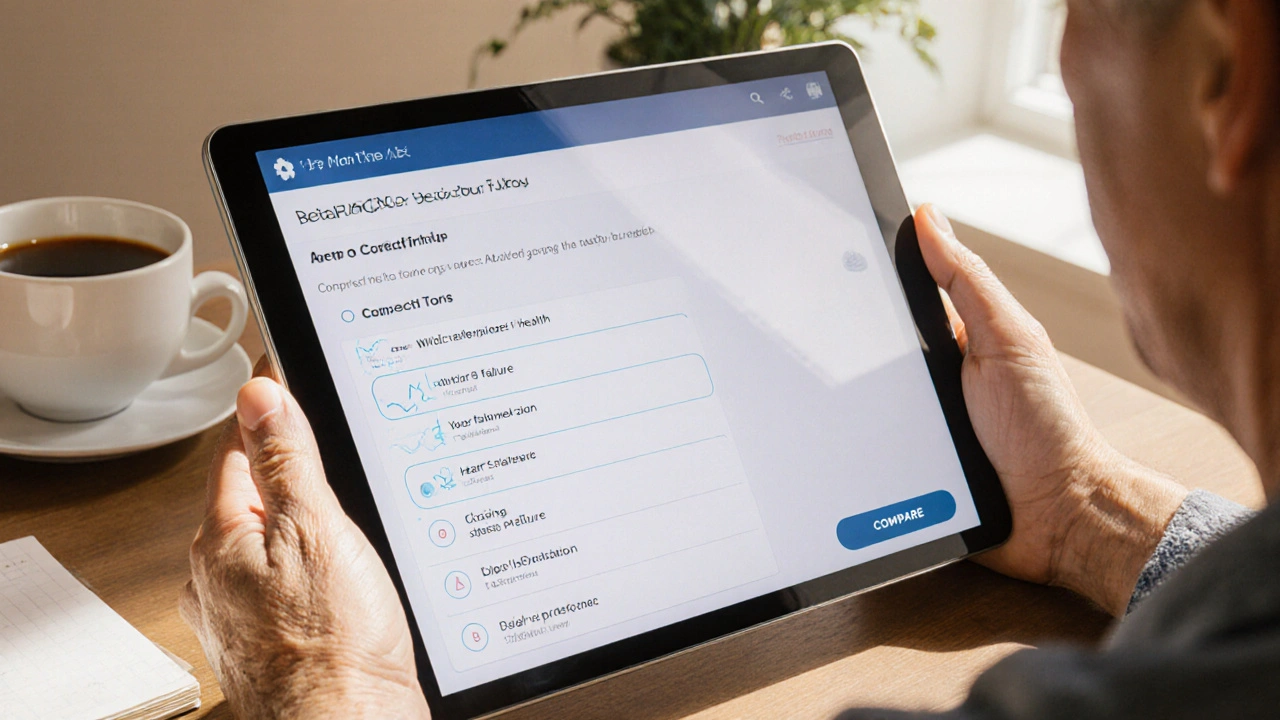Beta Blocker Selector Tool
Select Your Conditions
Choose your primary condition(s) and any relevant health factors to compare beta blockers.
Recommended Beta Blocker
Selectivity: Non-selective (β₁ & β₂)
Typical Daily Dose: 80-160 mg once daily
Half-Life: 3-5 hours
Main Indications: Hypertension, anxiety, migraine
- Bronchospasm (especially in those with asthma)
- Fatigue
- Sleep disturbances
Selectivity: β₁-selective
Typical Daily Dose: 50-100 mg once daily
Half-Life: 6-9 hours
Main Indications: Hypertension, angina, post-MI
- Cold hands/feet
- Mild fatigue
Selectivity: β₁-selective
Typical Daily Dose: 50-200 mg daily (ER 100-200 mg)
Half-Life: 3-7 hours (ER 5-7)
Main Indications: Hypertension, heart failure, arrhythmia
- Dizziness
- Depression
- Sexual dysfunction
Selectivity: Highly β₁-selective
Typical Daily Dose: 5-10 mg once daily
Half-Life: 10-12 hours
Main Indications: Heart failure, hypertension
- Bradycardia
- Fatigue
Selectivity: β₁/β₂ + α₁ blocker
Typical Daily Dose: 6.25-25 mg twice daily
Half-Life: 7-10 hours
Main Indications: Heart failure, post-MI, hypertension
- Orthostatic hypotension
- Weight gain
Key Takeaways
- Ranol SR is a once‑daily, sustained‑release version of propranolol, useful for hypertension, anxiety and migraine prevention.
- Its non‑selective action gives broader heart‑rate control but also more respiratory side effects than cardio‑selective alternatives.
- Compared with atenolol, metoprolol, bisoprolol and carvedilol, Ranol SR scores higher on dosing convenience but lower on asthma‑friendly profile.
- Choosing the right beta‑blocker depends on your primary condition, comorbidities and how you tolerate side effects.
- Consult a prescriber before switching; abrupt discontinuation can trigger rebound hypertension or tachycardia.
When managing cardiovascular conditions, Ranol SR is a sustained‑release formulation of propranolol, a non‑selective beta‑blocker that blocks both β₁ and β₂ receptors. It’s also listed as Propranolol SR. This setup allows once‑daily dosing for many patients, a major convenience boost over the immediate‑release tablets that need several doses each day.
What is Ranol SR (Propranolol)?
Ranol SR contains the active ingredient propranolol hydrochloride, a molecule discovered in the early 1960s. The “SR” stands for “sustained release,” meaning the tablet slowly dissolves over 24hours, delivering a steady plasma concentration. Standard immediate‑release propranolol usually comes in 10‑40mg tablets taken two to three times daily; Ranol SR packs 80mg or 160mg into a single tablet.
How Ranol SR Works
Propranolol blocks β‑adrenergic receptors in the heart, reducing the effects of adrenaline and noradrenaline. By lowering heart‑rate (negative chronotropic) and contractility (negative inotropic), it drops cardiac output and blood pressure. The drug also blunts the tremor or palpitations that many anxious patients feel, and it stabilises vascular tone in migraine‑prone individuals.
Typical Uses of Ranol SR
Because it hits both β₁ and β₂ receptors, Ranol SR is prescribed for:
- Essential Hypertension
- Performance anxiety or generalized anxiety disorder
- Migraine prophylaxis when other agents fail
- Certain arrhythmias, such as atrial fibrillation rate control
Its once‑daily schedule can improve adherence, especially for older adults who already manage several pills.
Alternatives on the Market
Not everyone tolerates a non‑selective blocker. Below are the most common alternatives, each with a distinct pharmacologic profile.
Atenolol is a cardio‑selective β₁ blocker that spares β₂ receptors, making it a safer choice for people with asthma.
Metoprolol is another β₁‑selective agent, available in immediate‑release (tablet) and extended‑release (succinate) forms.
Bisoprolol is a highly β₁‑selective blocker with a long half‑life, often used in heart‑failure regimens.
Carvedilol is a mixed α₁/β blocker that also has antioxidant properties, providing extra vasodilation.

Side‑Effect Landscape
Because Ranol SR blocks β₂ receptors, it can trigger bronchoconstriction, cold extremities, and fatigue more often than cardio‑selective drugs. Common side effects across the class include:
- Bradycardia (heart rate < 60bpm)
- Dizziness or light‑headedness
- Sleep disturbances, especially vivid dreams
- Gastro‑intestinal upset
Cardio‑selective alternatives (atenolol, metoprolol, bisoprolol) tend to cause fewer respiratory issues but may still lead to fatigue and sexual dysfunction.
Side‑by‑Side Comparison Table
| Drug | Selectivity | Typical Daily Dose | Half‑Life (hrs) | Main Indications | Notable Side Effects |
|---|---|---|---|---|---|
| Ranol SR (Propranolol) | Non‑selective (β₁ & β₂) | 80‑160mg once daily | 3-5 | Hypertension, anxiety, migraine | Bronchospasm, fatigue, sleep disturbance |
| Atenolol | β₁‑selective | 50‑100mg once daily | 6-9 | Hypertension, angina, post‑MI | Cold hands/feet, mild fatigue |
| Metoprolol | β₁‑selective | 50‑200mg daily (ER 100‑200mg) | 3-7 (ER 5-7) | Hypertension, heart failure, arrhythmia | Dizziness, depression, sexual dysfunction |
| Bisoprolol | Highly β₁‑selective | 5‑10mg once daily | 10‑12 | Heart failure, hypertension | Bradycardia, fatigue |
| Carvedilol | β₁/β₂ + α₁ blocker | 6.25‑25mg twice daily | 7-10 | Heart failure, post‑MI, hypertension | Orthostatic hypotension, weight gain |
Pros and Cons of Ranol SR vs Each Alternative
Ranol SR vs Atenolol
- Pros: Once‑daily dosing, effective for migraine prevention, works for tremor‑related anxiety.
- Cons: Higher risk of bronchospasm, less cardio‑selectivity.
Ranol SR vs Metoprolol
- Pros: Simpler regimen (no twice‑daily split), stronger β₂ blockade can help with certain tremors.
- Cons: More sleep‑related side effects, may worsen asthma.
Ranol SR vs Bisoprolol
- Pros: Wider therapeutic window for migraine; useful when heart‑failure is not a concern.
- Cons: Bisoprolol’s longer half‑life favours steady control, and its high β₁ selectivity means fewer respiratory problems.
Ranol SR vs Carvedilol
- Pros: Pure β‑blockade without α₁‑mediated vasodilation, which can be advantageous if you have low blood pressure.
- Cons: Carvedilol’s α₁ effect reduces peripheral resistance, helpful in heart‑failure patients where Ranol SR may be insufficient.
How to Choose the Right Beta Blocker for You
Consider these decision points before settling on Ranol SR or any alternative:
- Primary condition: If migraine is the main complaint, Ranol SR’s proven efficacy makes it a front‑runner. For pure hypertension without respiratory issues, a cardio‑selective drug may be smoother.
- Respiratory health: Asthma or COPD pushes you toward atenolol, metoprolol or bisoprolol.
- Heart‑failure status: Carvedilol or bisoprolol are guideline‑preferred; Ranol SR lacks the proven mortality benefit.
- Adherence factors: Once‑daily dosing (Ranol SR, atenolol, bisoprolol) beats twice‑daily regimens for many patients.
- Side‑effect tolerance: If vivid dreams or fatigue are a deal‑breaker, a lower‑dose cardio‑selective alternative might work better.
Practical Tips When Switching or Starting a Beta Blocker
- Never stop a beta blocker abruptly; taper over 1-2 weeks to avoid rebound hypertension.
- Check your pulse and blood pressure after the first dose; a drop below 50bpm or systolic <90mmHg warrants medical review.
- If you experience shortness of breath, discuss switching to a cardio‑selective agent.
- Keep a medication diary for the first 2 weeks, noting sleep quality, energy levels, and any trembling.
- Ask your prescriber about potential drug interactions - especially with antidiabetic meds, as beta blockers can mask hypoglycemia signs.
Frequently Asked Questions
Can I take Ranol SR if I have asthma?
Because Ranol SR blocks β₂ receptors, it can provoke bronchoconstriction. Most doctors will recommend a cardio‑selective blocker like atenolol or bisoprolol for asthmatic patients. If you must stay on propranolol, a very low dose and close monitoring are essential.
Why does Ranol SR cause vivid dreams?
Beta‑blockers cross the blood‑brain barrier and can influence REM sleep, leading to vivid or bizarre dreams. The effect is dose‑related; lowering the dose or switching to a more β₁‑selective agent often helps.
Is Ranol SR safe during pregnancy?
Propranolol is classified as Pregnancy Category C in the UK, meaning risk cannot be ruled out. It is sometimes used for specific heart conditions, but only under strict obstetric supervision. Discuss alternatives with your doctor.
How long does it take for Ranol SR to lower blood pressure?
Most patients see a measurable drop within 1-2 weeks, with the full effect appearing after 4-6 weeks of consistent dosing.
Can I combine Ranol SR with other blood‑pressure meds?
Yes, combination therapy is common. However, pairing with other agents that also lower heart rate (like verapamil) can cause excessive bradycardia. Always have a clinician review the full medication list.






